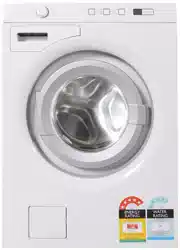Documents: Go to download!
User Manual
- Owner's manual - (English)
- W6444A - Asko - Specifications Sheet - (English)
- Description of the washing machine
- Dispenser
- Advice and tips before washing
- Washing
- Settings
- Care and cleaning
- Troubleshooting
Table of contents
Operating Instructions Washing Machine
Description of the washing machine

1. Main power switch
2. Dispenser
3. Program panel
4. Serial number plate (on inside of washer door)
5. Drainage pump cover
6. Drainage pump (behind cover)
7. Washer door
Dispenser
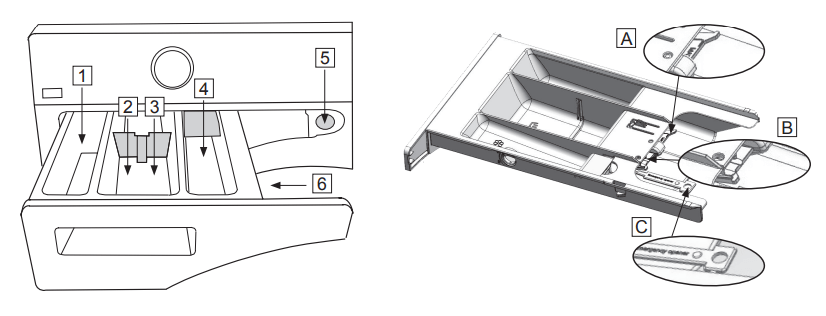
- Pre-wash

- Main wash with liquid detergent.

Use the separator (A). - Main wash with powder detergent.

Do not use the separator. - Fabric softener

- Release button
- Child safety catch
Advice and tips before washing
Here are some tips that may help you before washing.
Sorting your laundry
Sort items according to:
- how soiled they are
- colour
- material
Clothing
1. Do up zips and close Velcro straps so that they don’t harm fabrics.
2. New coloured items may contain excess dye and should therefore be washed separately the first few times.
3. Turn delicate items inside out. This reduces the risk of burling and fading.
4. Empty pockets and wash them inside out if possible.
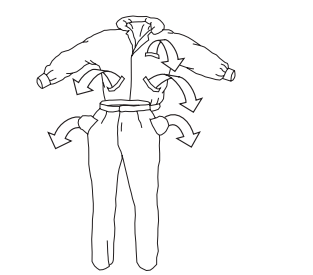
Laundry labels
Look at the item's laundry label. The table below shows suitable wash programmes for different materials and wash loads. Using modern washing machines and detergents, for example compact detergents, you can usually wash at lower temperatures. It is a good idea to use trial and error to find out what produces the best results.
Laundry label symbols
Examples of washing instructions and recommended programs. Always follow the washing instructions for each garment.
Laundry labels | Material | Program |
 | Cotton, linen, white and light-coloured items. | Everyday wash 60 °C to 95 °C |
Cotton, linen, cotton/polyester. Light and dark-coloured garments. | Quick 60 °C | |
Acrylic, viscose, modal, acetate, polyester, polyamide and elastane. Light and dark-coloured garments. | Easy Care 40 °C | |
Wool, silk and other very delicate garments | Wool/hand wash 30 °C to 40 °C |
Coloured cotton
Coloured cotton items with the washing instruction 60 °C should be washed at 60 °C for the first time in order to remove any excess dye. If you do not do so, there is a risk that the colour will run. Use detergent without bleach in order to preserve the colour of the fabric.
Unbleached linen
Unbleached linen fabrics should be washed at 60 °C, using detergent containing no bleach or optical whiteners. Heavily-soiled linen can occasionally be washed at higher temperatures, but not too often because the heat can destroy the linen’s shine and strength.
Wool
These fabrics are labelled either machine wash or hand wash. The Wool/hand wash program is at least as gentle as washing by hand.
Wool is especially sensitive to processes such as washing.
If you do not wish to spin dry, you can squeeze out the water using terry towels. In this case select No spin.
To find out how to choose this setting, see the""Washing" chapter. However, most garments can withstand a short spin. Choose a short spin by selecting a spin speed of 800 rpm or less.
Rayon fibres and synthetic fibres
Materials made of rayon fibres, such as viscose, and some synthetic fibres are very delicate and require much space so as not to crease. Only half fill the drum when washing and choose a spin speed of 800 rpm or lower.
NOTE!
Viscose and acetates are fragile when wet.
Reducing allergic reactions
The washing machine has a Super Rinse option. Use this for people with sensitive skin, such as those with allergies and small children.
Save time and energy
Use the Everyday wash program to save time and energy. This program has a shorter main wash than Normal, but is often sufficient for lightly soiled washing.
Economy and efficiency
You can save energy by not using higher temperature programs than necessary.
- Select Quick if you just need to freshen up shirts or exercise clothes, for example. This will save both water and energy.
- If you select a fast spin speed, this reduces energy consumption when drying in a tumble dryer or drying cabinet.
- Always wash with a full load when using the Heavy, Everyday wash and Normal programs.
- Avoid pre-washing. Modern machines and detergents clean effectively without prewashing. Pre-washing is only necessary for heavily soiled washing.
Detergents
Eco-labelled detergents are less harmful to the environment.
Detergent overdosing does not give better washing results; it merely causes a greater impact on the environment; can also hinder the wash performance.
Try to use less detergent, and increase only if you are not satisfied with the results.
Dyeing fabrics
If you want to dye fabrics in the machine, select the Everyday wash program with the Super Rinse option. Select temperature according to the dye manufacturer’s recommendations. Choose a low spin speed if the fabric to be dyed is a blended material such as polyester/cotton.
NOTE!
Add the dye directly to the washing drum - not to
the detergent compartment. After dyeing, you should run the machine empty using the same program. Use the normal amount of detergent.
NOTE!
Due to environmental concerns, we discourage the use of strong chemicals.
When using agents for bleaching or stain removal, there is a risk of rust (corrosion) and discolouration of the machine.
Washing
 Sort your laundry.
Sort your laundry.
See the "Advice and tips before washing" chapter.
Place underwired bras in a laundry net.
Empty pockets. Coins, nails and the like can cause damage to the machine and fabrics. See the "Advice and Tips" section before washing.
 Turn on the main power switch
Turn on the main power switch
NOTE!
Power on
Press the on/off button for min. 1 sec and max. 5 sec.
Power off
Press the on/off button for min. 5 sec.
If the ON/OFF command is not correctly accepted by the machine, wait min. 8 sec before any further press.
 Open the washer door and load the washing
Open the washer door and load the washing
If the washer door is closed, press the
Door opening button (key symbol). The door opens once all water has drained from the machine. Load the washing. The wash program chart shows how much washing can be washed with each program.
 Add detergent and fabric softener, as required
Add detergent and fabric softener, as required
The detergent packaging will have recommendations for how much detergent you should use. The machine holds 7 kg of washing. If you only have a small amount of laundry in the machine, you can reduce the amount of detergent used.
Powder detergent
Pour the powder into the compartment for the main wash, and pre-wash as well if desired.
Liquid detergent
When using a liquid detergent, observe the detergent manufacturer's recommendations. We recommend using a laundry ball with thick detergents. In the main detergent compartment, use the section wall (A) - see figure in the section Dispenser. Add the detergent into the front compartment of the detergent dispenser.
Wash ball or net
If you use a wash ball or net, place it directly in the drum and select a program without prewash.
NOTE!
Detergent overdosing does not give better washing results; it merely causes a greater impact on the environment; can also hinder the wash performance.
Try using less detergent, and increase only if you are not satisfied with the results.
Fabric softener
Pour the fabric softener into the compartment with the  symbol. Follow the recommendations on the fabric softener packaging.
symbol. Follow the recommendations on the fabric softener packaging.
NOTE!
Do not fill above the compartment’s maximum fill level. Otherwise fabric softener will run in too early, and will impair washing results.
 Program selection
Program selection
You select a programme by turning the programme selector. The selected programme is shown in the display. Now use the option buttons to select any options. See chapter Selecting Options.
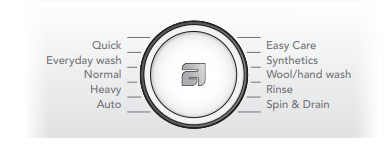
1. Auto
This program automatically adjusts the length of the main wash and the number of rinses to the amount of laundry loaded in the machine.
2. Heavy
Program for heavily soiled laundry, with dirt that needs to be fully dissolved before the main wash. A pre-wash is used to do this. You can select the temperature freely, so follow the washing instructions for each garment. The highest temperature, 95°C, is suitable for very heavily soiled laundry. The spin speed can be selected freely. The machine adapts the program time and water consumption to the load size.
3. Normal
Program for normal to heavily soiled laundry, whites and colours. You can select the temperature freely, so follow the washing instructions for each garment. 60°C is a good temperature for heavily soiled cotton garments, as well as for garments worn next to the skin. Select 40°C if the laundry is less soiled. The spin speed can be selected freely. The machine adapts the program time and water consumption to the load size.
4. Everyday wash
A standard program for lightly to moderately soiled laundry. The temperature can be selected freely, so follow the washing instructions for each garment. Garments worn next to the skin ought to be washed at 60°C. Very lightly soiled laundry often comes clean already at 40°C.
The spin speed can be selected freely. The machine adapts the program time and water consumption to the load size.
5. Quick
Fast program for laundry that just needs freshening up. The program can be run at any temperature, so follow the washing instructions for each garment.
The lower the selected temperature, the shorter the program time. Garments worn next to the skin ought to be washed at 60°C. The spin speed can be selected freely.
6. Easy Care
Program for synthetic, mixed fibre and easy care cotton. The program has a high water level and as such is also suitable for cushions, quilted jackets and the like. Read the washing instructions carefully and remember, for example, that fabric softener must not be used with the membranes found in some outer garments. A washing temperature up to 60°C and a spin speed up to 1200 rpm can be selected.
7. Synthetics
Program for delicate garments made of synthetic fibre, mixed fibre, rayon and easy care cotton. The maximum temperature is 60°C, but follow the washing instructions for each garment. Many synthetics will come clean at 40°C. Garments worn next to the skin ought to be washed at 60°C. The maximum spin speed is 800 rpm.
8. Wool/hand wash
A gentle laundry program for wool, silk and garments that should be washed by hand. The highest temperature is 30 °C. This program has a short spin. The maximum spin speed is 800 rpm.
9. Rinse
This program performs one cold rinse cycle + spin. Suitable for laundry that just needs to be dampened and for cleaning cloths and mops.
10. Spin & Drain
Used to just spin the wash. If you only want to drain the machine of water, select tilt the symbol (no spin).
the symbol (no spin).
Programme chart
Program | Pre¬ wash | Tempi °C | Number of rinses | Spin Speed rpm | Max load (kg) | Water consumption (approxi liter) | Energy consumption (approxi kWh) | Programme time (approx. hrs and mini) |
1. Auto |
|
|
|
|
|
|
|
|
2. Heavy | X | 95 | 5 | 1400 | 7 | 85 | 2.2 | 2:45 |
X | 60 | 5 | 1400 | 7 | 75 | 1.2 | 2:40 | |
3. Normal |
| 60 | 2 | 1400 | 7 | 60 | 1.13 | 3:21 |
| 40 | 2 | 1400 | 7 | 60 | 0.47 | 3:06 | |
4. Everyday wash |
| 60 | 3 | 1400 | 7 | 60 | 1.1 | 1:40 |
5. Quick |
| 40 | 2 | 1400 | 3.5 | 25 | 0.4 | 0:45 |
6. Easy Care |
| 40 | 2 | 1200 | 3.5 | 60 | 0.6 | 1:40 |
7. Synthetics |
| 40 | 3 | 800 | 2.5 | 30 | 0.4 | 1:20 |
8. Wool/hand wash |
| 30 | 3 | 800 | 2.5 | 70 | 0.5 | 0:50 |
9. Rinse |
|
| 1 | 1400 | 3.5 | 15 | 0.1 | 0:18 |
10. Spin & Drain |
|
|
| 1400 | 3.5 |
| 0.1 | 0:15 |
Consumption data may vary from the given values depending on variations in water pressure, water hardness, water inlet temperature, room temperature, fluctuations in the electricity, type and volume of the laundry and any extra options.
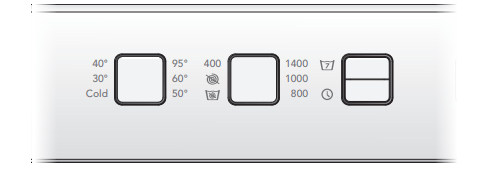
 Selecting options
Selecting options
You can select options to adjust the wash program to suit your own specific requirements. The available options depend on the selected program. If the option is available for the selected program, the symbols lights up when you press the button.
The machine will remember the options you select for each program (with one exception - Delayed Start). You can still change the selected options the next time you select the program in question.
 Temperature
Temperature
- Select the temperature by pressing the button until the LED by the desired temperature lights.
- You can select temperatures between 20°C and 95°C. For Wool/hand wash you cannot choose a temperature higher than 40°C. For Synthetics or Easy Care the maximum temperature is 60°C.
 Spin
Spin
Select the spin speed by pressing the button until the LED by the desired speed lights.
You can select speeds between 400 and 1400 rpm, No spin or No drain. The maximum spin speed varies according to the program selected, so check the LEDs around the button.
 means that the program does not include a spin cycle and ends by draining.
means that the program does not include a spin cycle and ends by draining. No drain means that the program does not include a spin cycle and ends with the water from the final rinse still in the machine. The washing will remain covered by the water from the final rinse, stopping it from getting creased.
No drain means that the program does not include a spin cycle and ends with the water from the final rinse still in the machine. The washing will remain covered by the water from the final rinse, stopping it from getting creased.
If you have selected "No drain", you must select the Spin & Drain program and the symbol  (no spin) once the program has ended to drain the water from the machine before you open the washer door.
(no spin) once the program has ended to drain the water from the machine before you open the washer door.
 Super rinse
Super rinse
Use the Super Rinse option if you want to increase the number of rinses. The maximum number of rinses is seven, and the number of rinses varies depending on the selected program. Recommended for persons with extremely sensitive skin and/or in areas with very soft water. This option cannot be selected with Rinse or Spin & Drain.
- Select Super Rinse by pressing the button under the symbol.
- An LED next to the button lights when this option is activated.
 Delayed start
Delayed start
When you select Delayed Start, the machine will start 1-24 hours after you press the Start/Stop button.
- Press the button by the symbol to activate Delayed Start.
- By pressing the button again you can delay the start in whole hours up to a maximum of 24 hours.
- Press Start/Stop, and the machine counts down 1 hour at a time and starts after the selected delay.
If you change your mind and want to cancel Delayed Start, you must press and hold Start/Stop for three seconds.
NOTE!
Remember to press the Start button to start the program..
NOTE!
Make sure the detergent compartment is completely dry before you add detergent, otherwise there is a risk that the detergent will clump before the machine starts.
 Close the washer door and press the Start/Stop button
Close the washer door and press the Start/Stop button
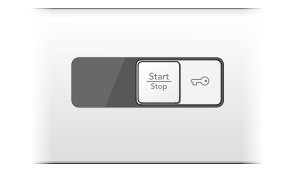
Time remaining
When the program starts an estimated program time, in hours and minutes, is displayed. The remaining time is updated three times during the program, based on the actual load and the incoming water temperature. The first update takes place after about 15 minutes. The remaining time is last updated just before the final rinse.
To add or remove washing after the program starts
If you want to add or remove items after the program has started, you can stop the program by pressing and holding the Door opening button (key symbol) for three seconds. The program time flashes on the display. When you restart the machine, add any extra detergent needed and close the washer door. The machine continues automatically from the point where the program was interrupted.
Stopping or changing a programme
You can stop a program by pressing the Start/ Stop button for three seconds. To restart the machine, select a new program, add any extra detergent needed and press the Start/Stop button.
NOTE!
Do not open the detergent compartment while the machine is running.
 Once the program has finished
Once the program has finished
The text "End" is shown on the display for 2 minutes. The machine then turns off.
The washer door opens automatically once the program has finished. If you want to deactivate the automatic door opening function, see the "Selecting settings" section.
- Remove the load.
If you have small children or pets at home, close the washer door once you have removed the laundry.
NOTE!
Upon completion of the washing cycle, close the water faucet and unplug the mains cord.
Settings
You can change the following settings
Automatic door opening.
Extra rinses.
Door opening
If you choose Automatic door opening the Washer door will open once the program has finished.
1. Turn off the machine using the main power switch.
2. Press and hold the Super rinse button and then switch on the main power switch.
3. “AdO” is shown on the display if Automatic door opening is activated or “AdF” if the option has not been activated.
4. Press the Super Rinse button to change the setting.
5. Press the Door opening button to save the setting.
Extra rinses
Upon delivery, your washing machine is set to use three rinses in the Normal and Everyday wash programs. If you want to increase the number of rinses to five for these programs, do as follows:
1. Turn off the machine using the main power switch.
2. Press and hold the Delayed start button and then switch on the main power switch.
3. The display shows "R O" if extra rinses (5 rinses) is activated or "R F" if it is not activated (3 rinses).
4. Turn the program selector to change the setting.
5. Press the Door opening button to save the setting.
Care and cleaning
Cleaning the trap and the drainage pump
The washing machine has a trap where smaller objects such as coins and hairpins can collect. To clean the trap and the drainage pump, do as follows:
- Make sure the machine is empty of water and switched off at the mains.
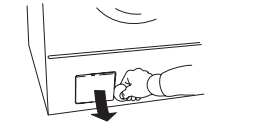
- Open the door.

- Unhook the drainage hose from the connector inside the door and drain the water into a suitable container, such as a shallow bowl.
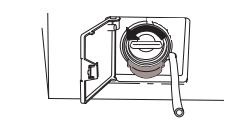
- Turn the cover anti-clockwise to open the pump. Remove the cover.

- Remove any items and so forth from the pump housing and the cover. Also check that the pump blades right at the back rotate.
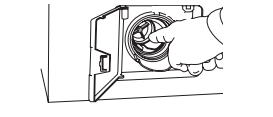
- Screw on the cover, replace the drainage hose on the hatch pin and close the hatch.
Cleaning the detergent compartment
Pull out the detergent compartment using the release button.

Rinse the compartment and scrub it clean. The cover in the fabric softener compartment can be removed.
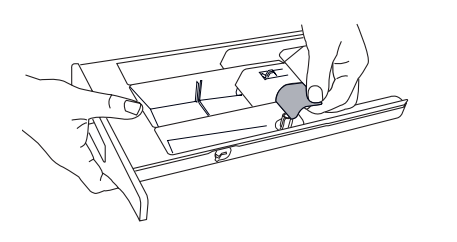
NOTE!
Do not run the detergent compartment through a dishwasher!
Cleaning the outside of the machine
Clean the outside of the machine and the program panel with a mild cleaner. Do not use any solvents, as these can damage the machine.
NOTE!
Maskinen ma ikke skylles med en vandstrale!
Cleaning the inside of the machine to avoid unpleasant smells
Modern detergents often allow clothes to be washed at low temperatures. This means that small deposits can build up in the machine. These, in turn, may lead to unpleasant smells developing.
To avoid this, we recommend running a 95°C wash programme once a month. When you do this, use a small quantity of detergent. It is not necessary to put any washing in the machine.
Rinse holes under the agitator
If you suspect that objects such as nails or paper clips may have fallen into the wash drum, you should check the space under the agitator. Such objects can rust and cause spots on clothing. Nails and other sharp objects can cause holes in fabrics.
Do as follows:
1. Insert a screwdriver or the like into the hole on the agitator as illustrated and carefully pry to the left.
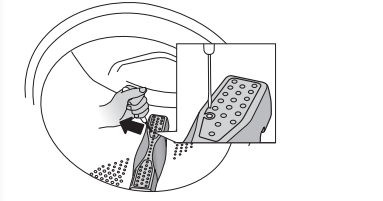
2. Use your other hand to grasp the agitator and pull it towards you.
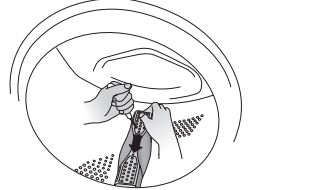
3. Lift the agitator.
4. Remove any objects.
5. Place the agitator in the mounting hole with the F-mark towards you. Ensure that all the agitator fasteners are in their holes in the drum. Push it in until it catches.

If you have hard water
If you live in an area with hard water (high limescale content), a greyish-white coating may form on the wash drum. To remove this coating, pour approximately 20 gram of citric acid into the wash drum and run any 95°C programme. Repeat if necessary.
Troubleshooting
The washer door will not open
1. Check that the main power switch is on.
2. Is there power? Check your home’s fuses (circuit breakers). The washer door cannot be opened with the Door opening button (with the key symbol) if power is off.
If nothing else works, the washer door can be opened as follows
WARNING!
The door may only be opened manually if the electric power is cut and the machine has been drained of water.
- Select the Spin & Drain program and the option with the
 symbol (no spin) to drain the water from the machine. If this does not work the machine must be drained manually. See "Cleaning the trap and the drainage pump" in the "Care and cleaning" chapter.
symbol (no spin) to drain the water from the machine. If this does not work the machine must be drained manually. See "Cleaning the trap and the drainage pump" in the "Care and cleaning" chapter. - Ensure that the main power switch is turned off and that the plug has been removed from the wall socket.
- Take the emergency door opening key (C) (see figure in the section Dispenser) and insert it into the slot on the right-hand side of the washing machine door latch. The key is attached on the back wall of the detergent dispenser. Remove the detergent dispenser from the washing machine and take the door opening key.
- Push the tool upwards to open the washer door.
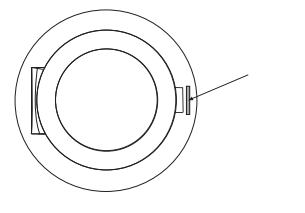
After use, store the emergency door opening key (C) in the dedicated compartment (B) (see image in the section Dispenser).
If in the future the washer door does not open when the wash program has finished, call the service division.
The machine will not start
1. Is the washer door properly closed? Push it firmly.
2. Is there power? Check the fuses and residual current devices (circuit breakers) in the building.
3. Check that you have not selected Delayed Start. To cancel Delayed Start, press the Start/Stop button for three seconds.
After power failure
Press the main power switch to resume the current program.
Wet washing still in the machine
A small load can under certain circumstances cause imbalance (see " Imbalance"). Rearrange the load and start the spin program, or load more washing and restart the washing program.
Error messages
If an error occurs during the program a message is shown on the display. To exit the message after taking measures, turn the machine off and then back on.
The error messages that may be shown in the display are:
F10 Overfilling
1. Shut off the water tap.
2. See "F11 Drainage error".
F11 Drainage error
Check:
- that no objects are stuck in the drainage hose outlet.
- that the drainage pump is not blocked by foreign objects. Clean the pump. See the "Care and cleaning" chapter.
- that there are no kinks in the drainage hose.
After taking measures, run the Drain program or press the Door opening button (key symbol) to empty the machine. If this does not resolve the problem, call the service division.
F12 Water inlet fault
Check:
- that the tap on the water pipe is open.
- that the filter in the machine’s water intake is not blocked.
Action:
1. Shut off the water tap.
2. Unscrew the hose.
3. Clean the filter in the inlet valve on the machine.
4. Screw the hose back on.
5. Turn on the tap and check for leaks.
6. Run the program again to check if the fault is fixed.
7. If this does not resolve the problem, call the service division.
 Imbalance
Imbalance
The machine stops the spin cycle if there is too much imbalance. The washing machine restarts the spin cycle and hopefully the washing is etter distributed in the drum. This procedure can be repeated up to 10 times. If the machine still fails to find a good balance, the program jumps to the next step.
The error message requires no action.
Transport protection
Remove the three transport bolts and the plastic plugs for locking the machine for transport before using the machine.
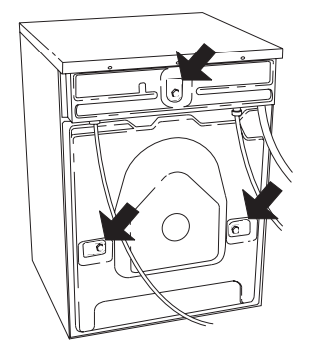
1. Loosen and remove the bolts as illustrated below.
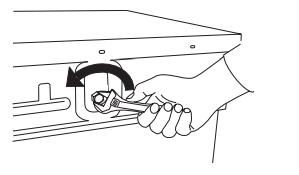
2. To remove the plastic plugs that held the bolts, squeeze together and pull out.
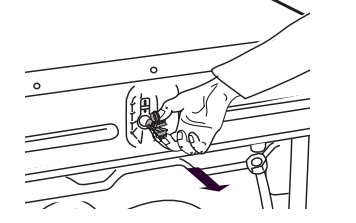
3. Remove the plastic covers from the plugs. Push the plastic covers into the three holes that contained the plugs. Save the plastic plugs in case the machine is moved in the future.
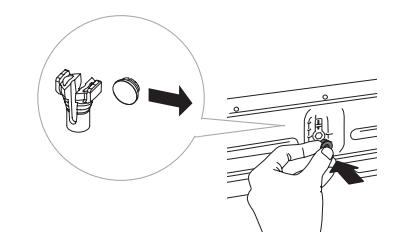
NOTE!
If the machine is to be transported, the bolts and plastic plugs for locking the machine during transport must be installed to prevent damage to the machine through shaking. If the transport bolts or plastic plugs have been lost, you can order new ones from your retailer.
Before contacting the service division
Before you contact the service division, make sure that you know the model number (located on the front panel), and serial number.
The model designation can be found on the panel. The type designation and serial number can be found on the type plate on the inside of the washer door.
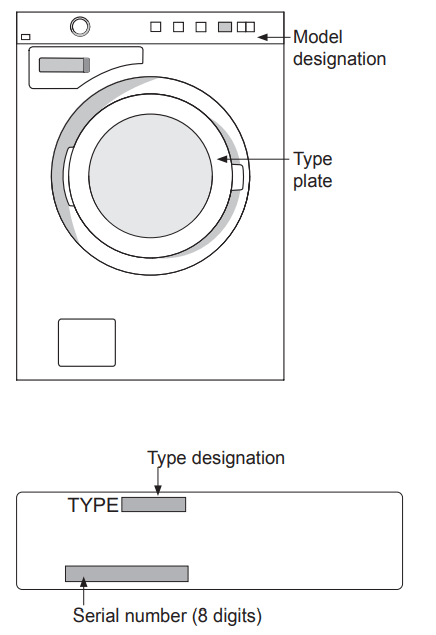
See other models: W4086P.W 1827 DBI664THXXLS 101 T14100
